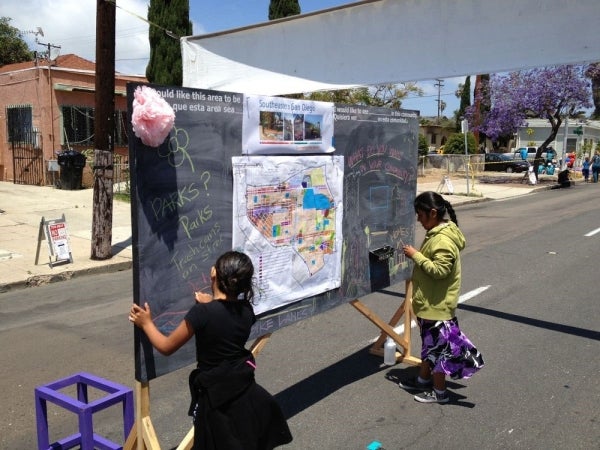Inclusive Engagement Techniques and Approaches
Vision Walls

What is it?
Vision walls are collaborative physical or digital displays on which participants provide input by writing, drawing or posting notes and images. Vision walls can facilitate creative input and make the engagement processes more transparent by allowing participants to view each other’s feedback.
When to use it
Vision walls are most effective during the early stages of a project for soliciting a broad range of community input. They may also be integrated as an activity within techniques like workshops, open houses or pop-up events to capture the public’s attention and encourage spontaneous engagement.
How to do it
Before
- Clearly define what kind of input is desired and how it will be used in the project.
- Decide whether the vision wall will be physical or digital.
- For physical vision walls:
- Choose a surface that would be appropriate for the activity, such as a whiteboard, posterboard or large sheet of paper.
- Consider size/dimensions so that the vision wall is eye-catching, provides enough space for input and fits in the area it will be displayed.
- For physical vision walls:
- Create a visually appealing design that encourages engagement.
- Include prompts or questions to guide input using clear, simple and inclusive language.
- Leave enough space for multiple contributions.
- Gather materials such as markers, sticky notes, stickers and other creative supplies for people to provide input on physical walls. For digital walls, set up the platform and test its functionality.
- Identify high-traffic areas or events where the vision wall can be most visible.
- Obtain any necessary approvals if considering a vision wall on private property. Vision walls of a large scale in the public right-of-way may require a special event permit.
During
- Set up the vision wall at the identified location.
- Describe its purpose to participants and explain how input will be used.
- Provide participants ample time to visit each wall and post their input.
After
- Take pictures of the vision wall and/or digitize the input. Analyze common themes to inform project decision-making.
- Consider displaying vision wall contributions on the project’s webpage / in an engagement summary.
Resource considerations
![]()
Cost: Minimal
Physical walls may require minimal material costs like posters, markers and display boards. There are free digital wall platforms but some may involve platform setup and maintenance fees.
![]()
Time: Minimal
Planning, designing and setting up a vision wall can take up to a couple of weeks, depending on complexity.
![]()
Capacity: Minimal
One to two staff can implement an effective vision wall.
How to make it more inclusive
- Identify any language access needs in advance.
- Design physical vision walls that consider people’s varying heights and reach, including those using wheelchairs. For digital walls, choose a platform that is user-friendly and compatible with assistive technologies.
- Offer to post input on the wall for the participants if they feel more comfortable verbalizing their input as opposed to writing/drawing.
Inclusive Engagement Techniques and Approaches
- Introduction
- Appreciative Inquiry
- Arts-based Engagement
- Briefings
- Comment Forms
- Community Cafés
- Community Mapping
- Community Office Hours
- Email Notifications
- Engagement through Service
- Fact Sheets
- Flyers
- Focus Groups
- Game-based Approaches
- Hotlines
- Information Kiosks
- Interviews
- Meeting in a Box
- Mobile Engagement
- News Releases
- Newsletters
- Open Houses
- Participation Support
- Pop-Up Events
- Project Models
- Project-specific Groups
- Public Meetings
- Public Service Announcements (PSAs)
- Social Media
- Surveys and Polls
- Tours and Field Trips
- TV/Radio/Podcast Interviews
- Vision Walls
- Web-Based/Hybrid Meetings
- Webpages
- Workshops


 Inclusive Public Engagement Guide
Inclusive Public Engagement Guide